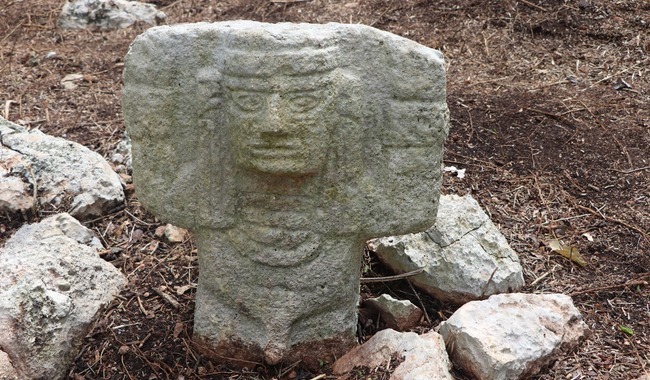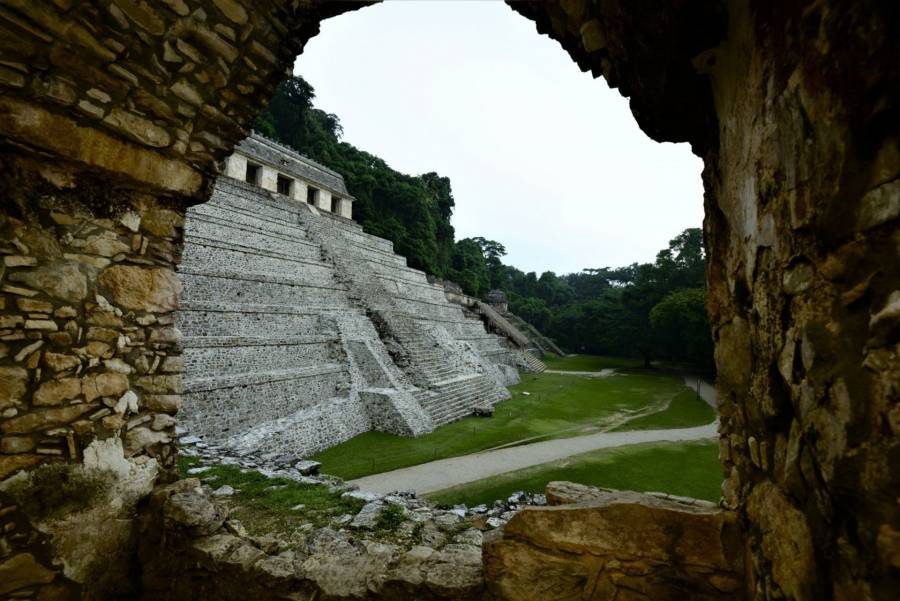Latin America
Related: About this forumAncient Atlantean Sculpture Discovered At The Mayan Chichen Itza Archaeological Site
AncientPages.com | August 29, 2023
Jan Bartek - AncientPages.com - An ancient Atlantean sculpture with arms raised has been discovered during works preparing a road that will lead to a new section of Chichén Itzá in the Yucatán Peninsula of Mexico.
Chichen Itza, a UNESCO World Heritage Site, is one of the most visited Mexico's archeological sites. Famous for its impressive structures, including the Kukulkan Pyramid, the Temple of the Warriors, and the Ball Court, Chichen Itza offers a unique opportunity to travel back in time and explore the history of the ancient Maya.

Image credit: INAH
Archaeologists working at Chichen Itza keep making discoveries that provide a more comprehensive picture of the ancient Maya civilization.
In a recent press conference, scientists from INAH (Instituto Nacional de Antropología e Historia) announced the discovery of an ancient Atlantean sculpture measuring 90 cm in height.
The newly recovered sculpture, in association with a housing complex, adds to a series of elements that show that there was an important common base between the Mayan culture of Chichén Itzá, in the Terminal Classic and Early Postclassic periods and those of the central and northwestern central Mexico, at approximately the same dates, between AD 800 and 1200, even later.

The location where the Atlantean sculpture was unearthed. Image credit: INAH
More:
https://www.ancientpages.com/2023/08/29/ancient-atlantean-sculpture-chichen-itza/
eShirl
(18,792 posts)I don't get it.
update
A-ha! Learned something new.
https://en.wikipedia.org/wiki/Atlantean_figures
sinkingfeeling
(52,993 posts)As to the word 'Atlantean' associated with the statues, this name was given to them because of their similarity to the load-bearing figures like Atlas, a Titan god of endurance in Greek mythology. Atlas was responsible for maintaining the weight of the world.
eShirl
(18,792 posts)Judi Lynn
(162,384 posts)Ocelot II
(120,854 posts)"As to the word 'Atlantean' associated with the statues, this name was given to them because of their similarity to the load-bearing figures like Atlas, a Titan god of endurance in Greek mythology. Atlas was responsible for maintaining the weight of the world.
The newly unearthed sculpture at Chichen Itza is small compared to the Atlantean statues in the ancient Toltec' city of Tula. As previously said on Ancient pages, the enigmatic gigantic basalt figures of Tula "are over 15 feet (4.5 m) tall. Their weight is between 8 and 8.5 tons, and they have a diameter of one meter."
It always helps to read the linked material...
Judi Lynn
(162,384 posts)Judi Lynn
(162,384 posts)The Atlantean figures are four anthropomorphic statues belonging to the Toltec culture in pre-Columbian Mesoamerica. These figures are "massive statues of Toltec warriors".[1] They take their post-Columbian name from the European tradition of similar Atlas or Atalante figures in classical architecture.
Though the most famous Atlantean figures reside in Tula, the Olmecs were the first to use Atlantean figures on a relief discovered in Potrero Nuevo.[2] Mayan sculptors also created "Atlantean" figures in Chichen Itza. Furthermore, the Aztecs also created warrior statues strongly inspired by these Atlantean figures in Tula.[3]
Composition
The Atlantean figures in Tula are hand-carved statues made from the available stone in the area: limestone, sandstone, and volcanic rock. To carve them, sculptors would have used stone tools, such as chisels for fine sculpting, scrapers of various sizes, and stone hammers. Additional smaller and softer stones were used for smoothing. The process of creating these figures would have been very time-consuming, which is an indication to the importance of these figures to its civilization.
Earliest example of Atlantes in Mesoamerica
At Potrero Nuevo near San Lorenzo, part of San Lorenzo Tenochtitlán, there is an altar supported by two Atlantean figures created by The Olmecs. It is believed to be the "oldest Mesoamerican example of the themes of atlantes holding up altars or ceilings"[2] The atlantes at this site are also unique compared to those found at other sites. The atlantes are not carved in the round like they are at later sites, rather they are carved as a relief.
Toltec Atlantean figures from Tula
Tula has long been considered the capital for the Toltec people. At Tula one can find the Temple of Tlahuizcalpantecuhtli ('House of the Morning Star' or 'The Temple of the Lord in the Dawn'), where there are four Atlantean figures standing over 4.6 metres (15 ft) tall. The figures here are depicted as wearing "stylized butterfly breastplates, sun-shaped shields on their backs, feathered headdresses and carry spear throwers and a supply of spears".[4]
. . .
Mayan Atlantean figures from Chichen Itza
Built by the Maya people, Chichen Itza is a site located on the northern center of the Yucatan Peninsula and contains what is known as the Temple of Warriors. At the top of the temple, used as support for the roof, run columns of the carved warriors, each wearing a feathered headdress, a butterfly-shaped pectoral, and holding a dart thrower and darts.[1] Like the Atlantean figures in Tula, the figures from Chichen Itza have not been dated exactly. The construction of Chichen Itza took place between A.D.100-250.
Built by the Maya people, Chichen Itza is a site located on the northern center of the Yucatan Peninsula and contains what is known as the Temple of Warriors. At the top of the temple, used as support for the roof, run columns of the carved warriors, each wearing a feathered headdress, a butterfly-shaped pectoral, and holding a dart thrower and darts.[1] Like the Atlantean figures in Tula, the figures from Chichen Itza have not been dated exactly. The construction of Chichen Itza took place between A.D.100-250.
More:
https://en.wikipedia.org/wiki/Atlantean_figures
Hermit-The-Prog
(36,588 posts)That first image looks like a man who took off his head and is holding it between his hands in front of his chest. Can't tell by his facial expression if he's displeased with the situation or not.